Page published: 9 February 2021
 OCSG? - The Open Canoe Sailing Group
OCSG? - The Open Canoe Sailing Group
Between 2004-2009 I wrote a column that appeared in "Norfolk Afloat", a magazine that, from January 2007, became "Anglia Afloat". Shortly before the change I also began writing articles in the magazine. This was the second one I submitted that related an event on the Norfolk Boards.
The article covered a Meet of the Open Canoe Sailing Group held at Hickling Broad, as guests of Hickling Sailing Club. The version seen below is some 75 words longer than than the version published in the magazine. Not reproduced below was a small Fact File "box-out" giving details of where the group operated and contact details. The other large box-out that I had given the working title What Makes A Sailing Canoe had become "Fed up with man-power? The answer's blowin' in the wind" by the time the editor's pen had re-worked the piece and the magazine was published. However, it did, almost, retain the head and strap line I had suggested:
Sail when you can and paddle when you must
Greg Chapman discovers you don't have to paddle your own canoe
The other significant difference in the material presented here compared to the published article is the number of photographs. I supplied 16 to the magazine, which are all presented here with the captions I suggested, while the editor used just five.

The article appeared on pages 42-44 in the Nov-Dec 2006 edition of Norfolk Afloat.
 The Article as Submitted
The Article as Submitted
The Open Canoe Sailing Group made what has become an annual trip to the Broads in June. With their slogan in mind, they took advantage of some great summer weather, with near ideal conditions both for camping and sailing.
It was Dave Thorn, from Lancashire, who had organised both this and the two previous Norfolk Broads meetings. In 2004, the OCSG had been hosted by the Norfolk Punt Club at Barton Broad. It was an obvious partnership, as the two groups might be described as having a similar history. Both had their origins in the mid-nineteenth century. While Scotland provided the focus for mounting sailing rigs on open canoes, in Norfolk much the same was happening with the equivalent local craft, the wild fowler's punt. However, last year, Hickling Sailing Club was asked to host the event and the venue proved popular with those who attended that Dave was asked to arrange a return trip this year.

Dave Stubbs in his strip wood Solway Dory Avocet (OC71) with Steve Robinson (OC131), OCSG chairman, in a GRP example.
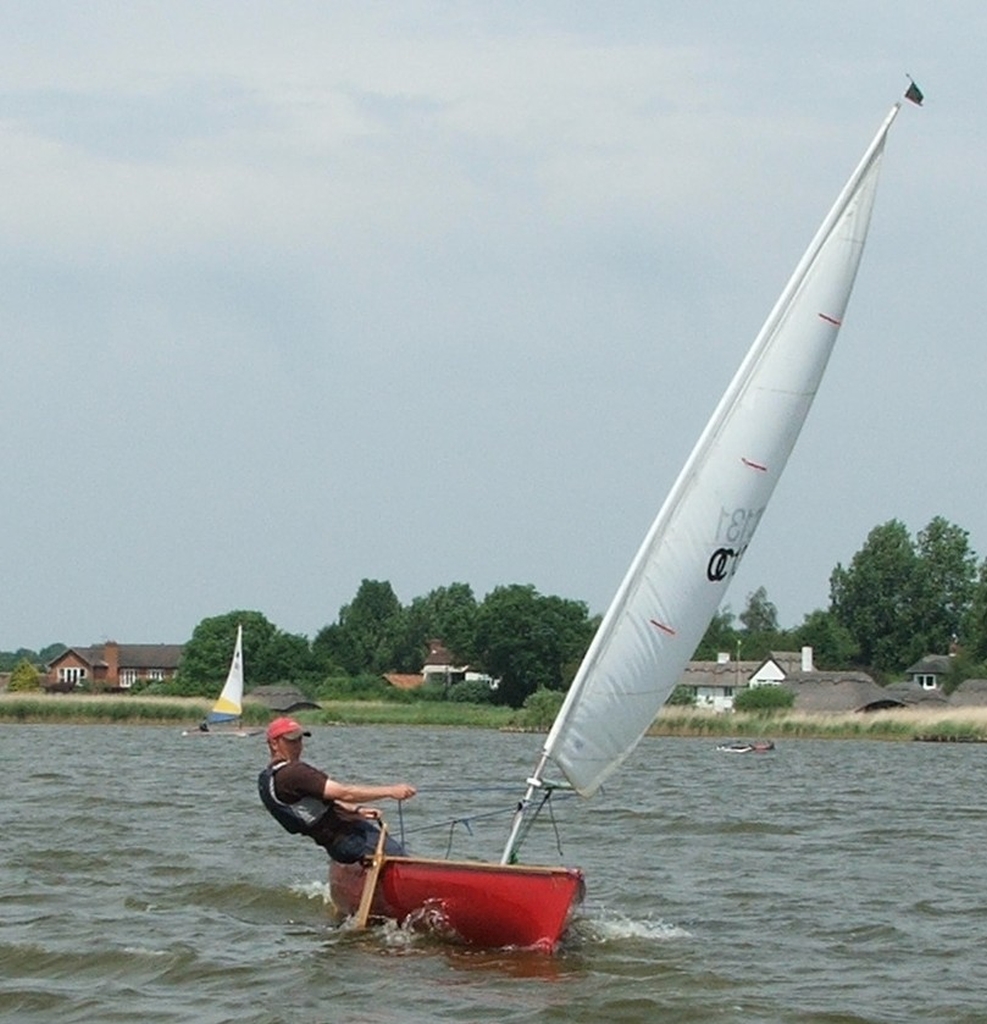
Steve Robinson, reaching across Hickling Broad, with its famous thatched boat houses in the background.
The OCSG was formed in 1990, to bring together those interested in sailing their canoes. The members keep it informal, relaxed and sociable. The group's web site even suggests that any seriousness and over-competitiveness is likely to be treated with gentle teasing. And that's just how it was as I joined members of the group, sitting round a picnic table at Hickling Sailing Club.
They had just finished a morning's racing, and members were relaxing in the sun when I arrived. Jibes were being tossed light-heartedly about aimed at those who bought purpose-built sailing canoes. Around the table, flanking Steve Robinson, chairman of the group and Keith Morris, the Commodore, were those both those members who had added a sailing rig to their standard paddling canoes and the people from "Solway Dory", the only UK-based company to manufacture canoes purpose-built for sailing.
Answering some of my questions, Steve explained how the club membership was made up both of those who come from a canoe background and move into sailing them and those who have sailed larger craft and turn to sailing canoes for the simplicity and cost advantages. Steve himself belonged to the first group, moving to sailing his canoe some six years ago, since when he had become an RYA senior sailing instructor.
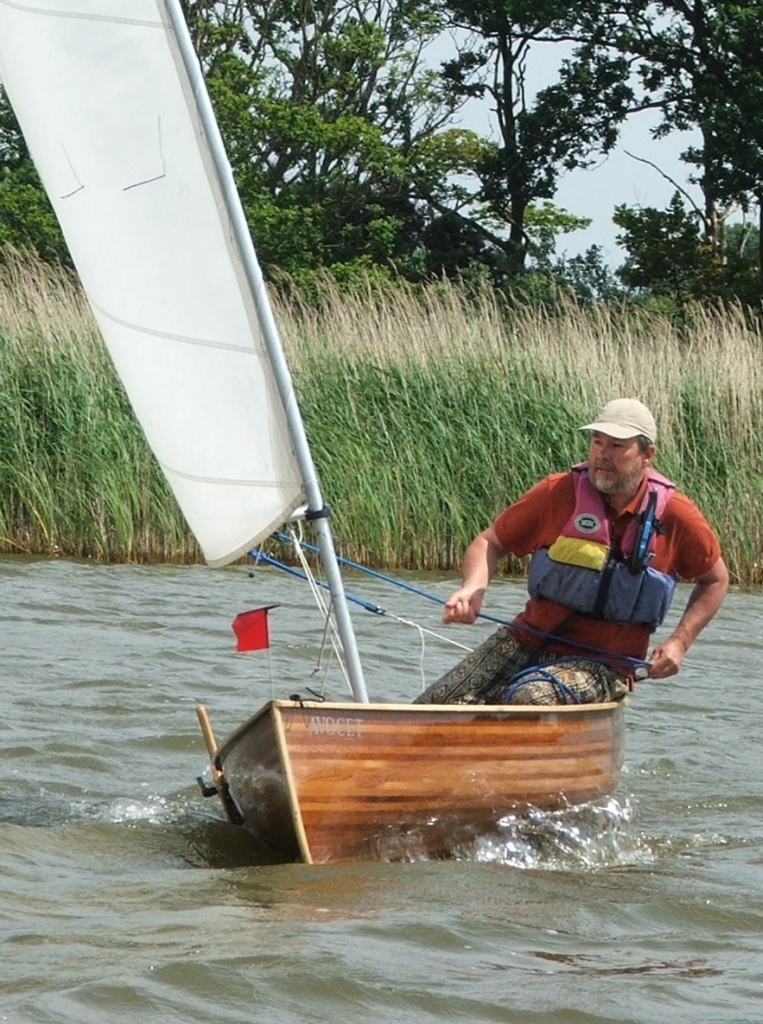
Dave Stubbs uses a bow mounted burgee. It saves the neck muscles!
"We're not a one design class", he continued. "This means that people can have just the right boat for them. For many that means a cruising boat. But, if they do come to one of the group events, they can join in any racing on a fully competitive basis. The trouble with most dinghy classes is that they're only good for one thing - racing, but an open canoe that compiles with group rules can be used for day sailing, extended camping expeditions or racing. It the best of all worlds, and doesn't need to break the bank." Indeed, one member of the group told me he had won races in a canoe that cost him just seventy five pounds.
Earlier I had spoken to Dave Poskitt, who took over "Solway Dory", in 1998, from John Bull. John was a leading light in the revival of canoe sailing, which had first become popular in the UK in the 1860s. He had founded Solway Dory in 1981. Originally based at Kirkbride on the Solway Firth, John had also designed dories, hence the company name. By 2001 Dave's wife, Jan, and Dave Stubbs had joined him as partners. They reckon that Solway Dory is now the principal supplier of open canoe sailing rigs in Europe. They also design and make a range of canoes specially designed for sailing and will even accept commissions for special purpose craft.
The first thing that I had noticed about two of Solway Dory's designs, the "Curlew" and "Avocet" was how wide they were. At 40" beam they were the widest canoes I had seen. Dave explained. "The Avocet was designed as a sailing canoe for two people and their camping gear", continuing, "There are subtle differences from a conventional paddling canoe. There is no tumblehome on these boats, which means they don't get narrower at the top. This gives greater final stability and a drier ride. We've built in extra stiffness where a sailing canoe needs it, around the thwart that supports the mast, and where the lee board is attached".
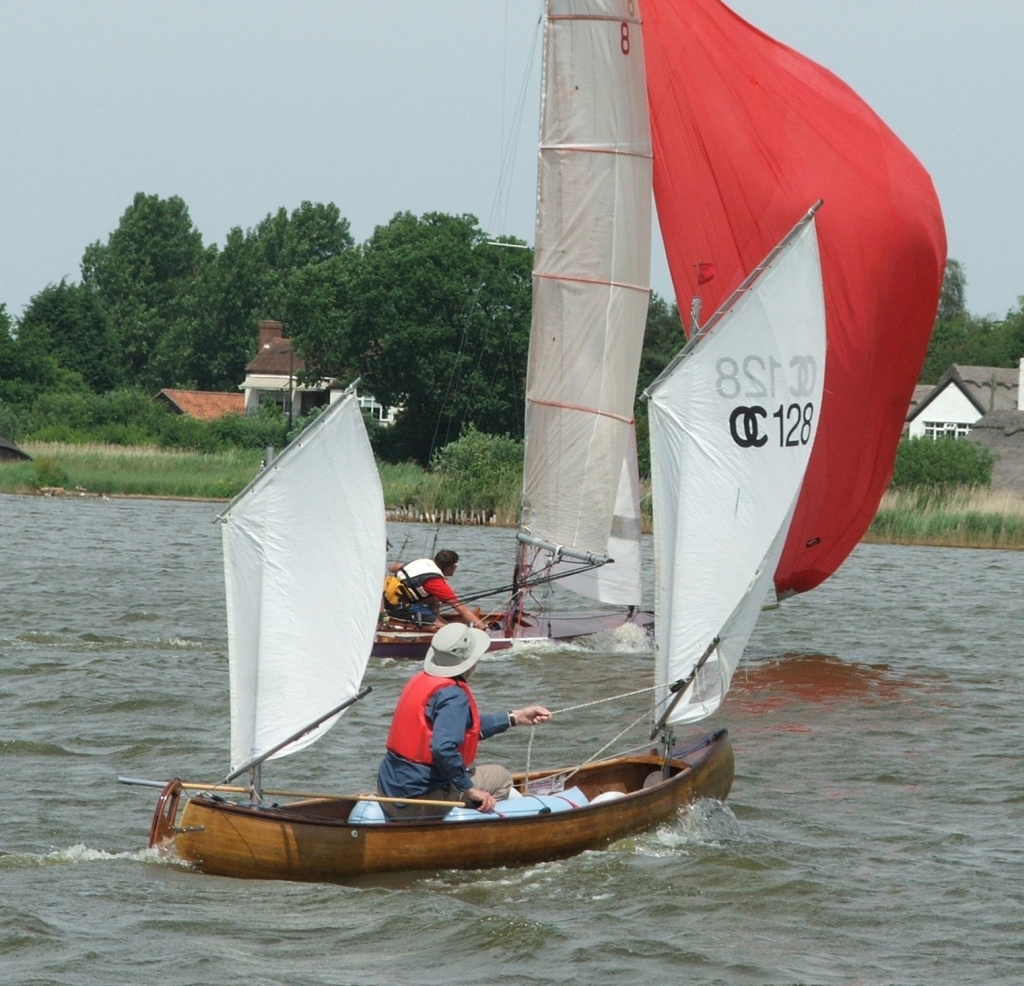
Warin Kelly's home-built ketch rigged canoe is out run by a Norfolk Punt.
The Avocet can also be supplied with built-in buoyancy tanks, rather than the more conventional, and more easily damaged, bags. These make for a slightly wider gunwale on which it is more comfortable to sit out, while also providing a pair of vertical surfaces on which brackets can be provided on which to hang seating in a variety of configurations. "Some of our customers want these options so they can use the boat for both single and double handed use", said Dave, concluding, "We have always wanted to build up a stock of boats, but we sell them as fast as we make them, so effectively each is custom built to order."
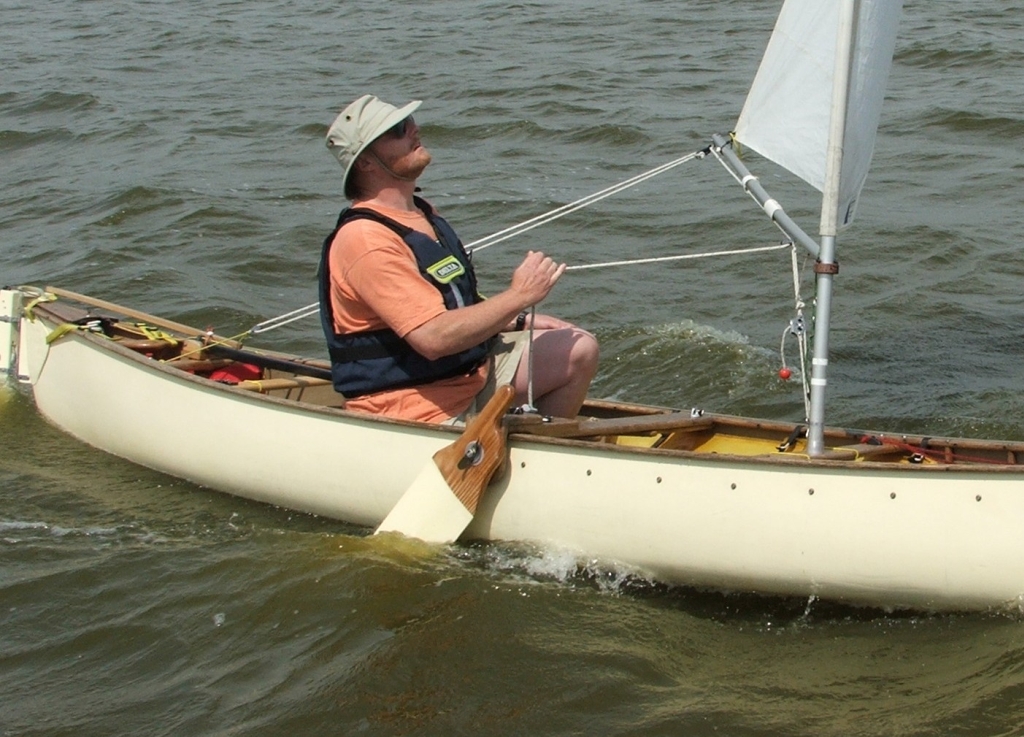
Keith Morris, the OCSG Commodore, converted his Mad River Explorer to a sailing canoe. Note the strap-on rudder assembly.
The strip wood plank version of the Avocet that the Poskitts had brought with them is not a cheap boat at £4000, but it was beautiful. It was almost impossible to see the very fine grade woven glass fibre embedded in the resin coating to both sides of the hull. When I commented that it must take some effort keeping it looking that good, Jan said "This one is two years old now and we haven't done anything to it. Of course, one of the advantages of wood is that it's much lighter than a GRP boat."

Dave Stubbs (OC71) with Steve Robinson (OC131) in hot pursuit.
The GRP Curlew that they also had with them was far more affordable and would come complete with rig of the buyers choice. At fourteen feet the Curlew, is two feet shorter than the Avocet and is designed for single handing. The shorter length means that it is lighter too, so that makes it easier for one person to lift onto the roof rack on their car."

Warin Kelly's boat has the typical 30 plus 14 sq ft ketch rig. With very short masts the boat barely heels even on a broad reach, allowing Warren to sit comfortably on the centre plate housing.
So having learnt a bit about the boats and the group, it was time for the members to show me what they could do. Picking a moment between Hickling Sail Club's race starts, I took my SeaHawk across the broad away from the racing line and dropped mud weight. Almost before I knew it the canoes were all there, tacking and gybing round me, even the boats that weren't "dressed to race". One of the advantages of such small sails is that most of the owners at the event found it perfectly affordable to have a Bermudan racing rig available for OCSG events and a lug sail ketch rig for cruising at other times. So might you when you are told that the aluminium tubing for a new 11ft mast is going to cost less than twenty pounds.
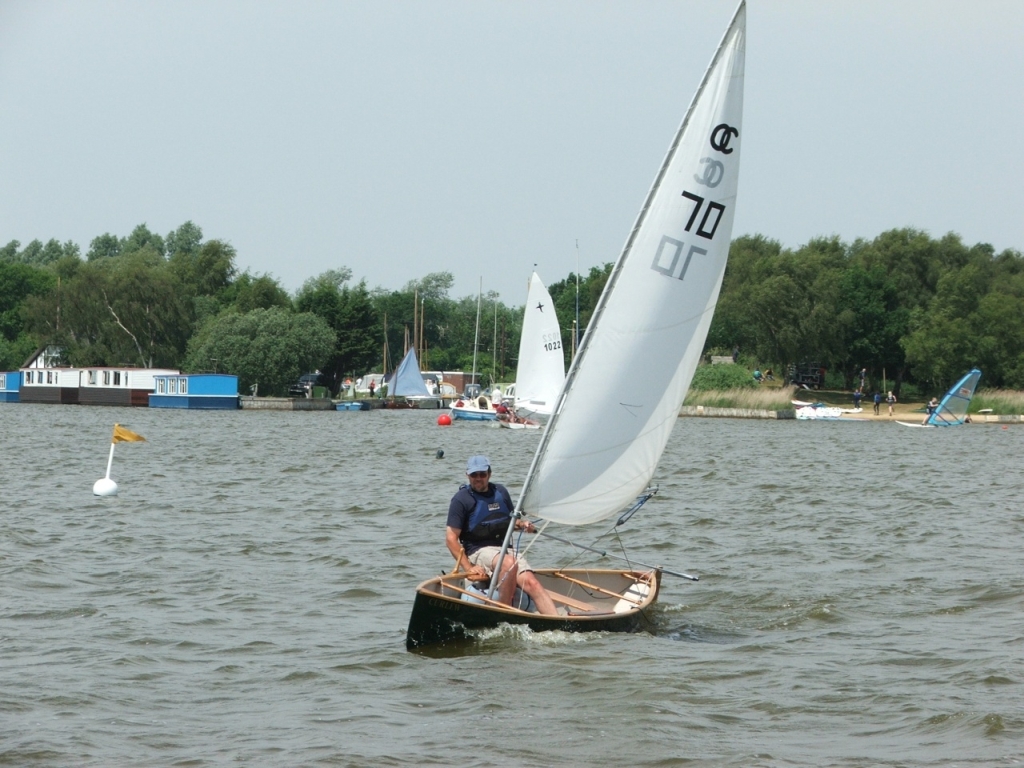
Dave Poskitt in a standard Solway Dory Curlew fitted with their high aspect 16' 2" mast and 44sq ft Bermudan rig.
Once I'd got all the photographs I wanted, it was back to the club, where some of the members were beginning to pack up their boats and make their long way home from the event. There was just time to hear a little of Solway Dory's experiments with electric outboards for canoe use and a little more of the light-hearted jests in the "You don't have to pay the earth to get a winning boat" battle. Jan Poskitt, conceded that while she didn't think of herself as competitive, said "I thought I could sail, before I started racing. I learnt a lot from copying others." When my own wife chipped in to the conversation saying of me "He's a monster once he gets on board", Jan revealed another advantage of sailing canoes. "I can't sail with Dave either", she said. So that's why they brought three boats with them - easy when they're only canoes!

Warin Kelly, aboard his home-built Jemima, Hickling Sailing Club's headquarters in the background.
And the last word from Steve, who quoted the groups founder John Bull; "The pleasure to be had from sailing a canoe is out of all proportion to the very modest investment it requires"
 What Makes a Sailing Canoe
What Makes a Sailing Canoe
Almost any canoe can have some kind of rig mounted on it. A sheet of polythene held aloft will allow you to go downwind without having to paddle. However, to move across or even up wind you need a properly mounted sail, which you can trim for the conditions, and some form of keel.
The OCSG maintain that a "general purpose" canoe fourteen to seventeen feet long, between 34 and 38 wide and with a depth of 12 to 15 inches is a perfectly good basis for a sailing canoe. In other words, almost any canoe you are likely to find.
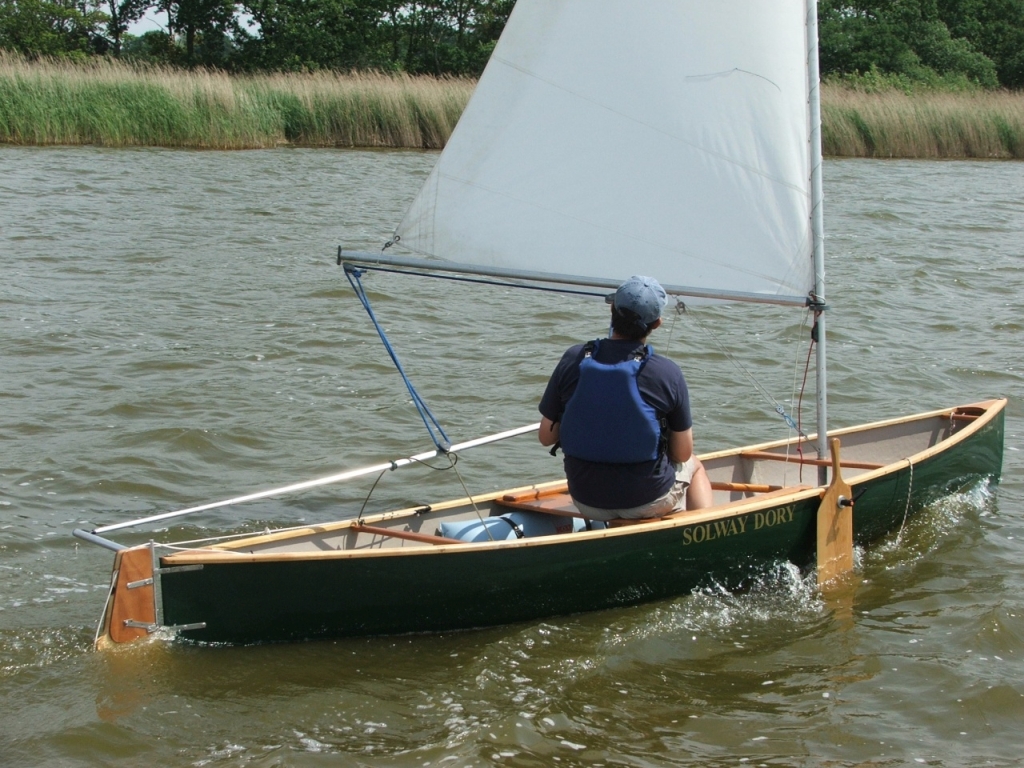
A Solway Dory Curlew: Note how the massive tiller extension passes through the main sheet bridle and the main sheet itself is brought well forward on the boom. If you drop either, they remain close at hand.
After some years of trying to define a "canoe" the group settled on simply defining a sail area (44 square feet) and not concerning itself with hull design as the criteria for class membership. As a result, in spite of its name, these days you will find decked canoes displaying the groups "overlapping "OC" sail emblem. The total area need not be all in one sail, though for racing a Bermudan rig is found the most efficient.

Nigel Cross sails his plywood kayak, which sports an old Optimist dinghy sail, now gaff rather than sprit rigged. Nigel uses a larger jib when cruising. This one keeps the rig within the OCSG 44sq ft limit.
Those who use their boat primarily for cruising frequently rig their canoe as a lug-sailed ketch. The much shorter spars are more easily stowed making life easier when forced to paddle, especially if a lot of camping gear is being carried. There is also less heel than with the taller Bermudan rig so it allows the crew to relax more comfortably in the bottom of their boat, rather than force them to perch on the gunwale ready to counteract every gust. With the masts at the extremities of the boat it also leaves more room for crew in the middle, important if there are two people to accommodate.

Nigel Cross's kayak has a single outrigger to starboard. Initially he sailed the boat without a leeboard but does now use one.
With nothing in the rules defining a canoe, another option is to retain the narrow hull of a conventional paddling canoe and fit out-riggers. When not racing a slightly larger rig than standard also becomes feasible.
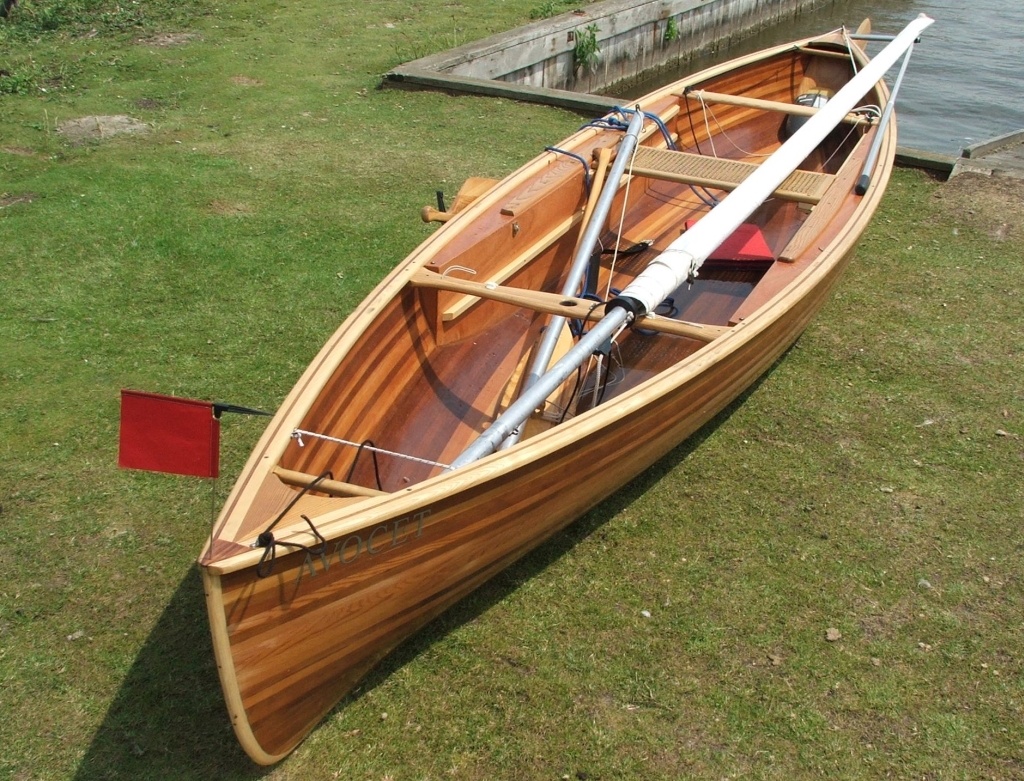
A strip wood Solway Dory Avocet. The buoyancy tanks are fitted with rails allowing the supplied rattan seat(s) to be placed to best position the crew.
The keel used is normally a single lee board, fixed to one side of the boat. A single bolt will permit it to be easily raised when paddling or should it hit an obstruction when sailing. As canoes are narrow twin lee boards are unnecessary, the one blade going deep enough to prevent drift, even on the "wrong" tack.
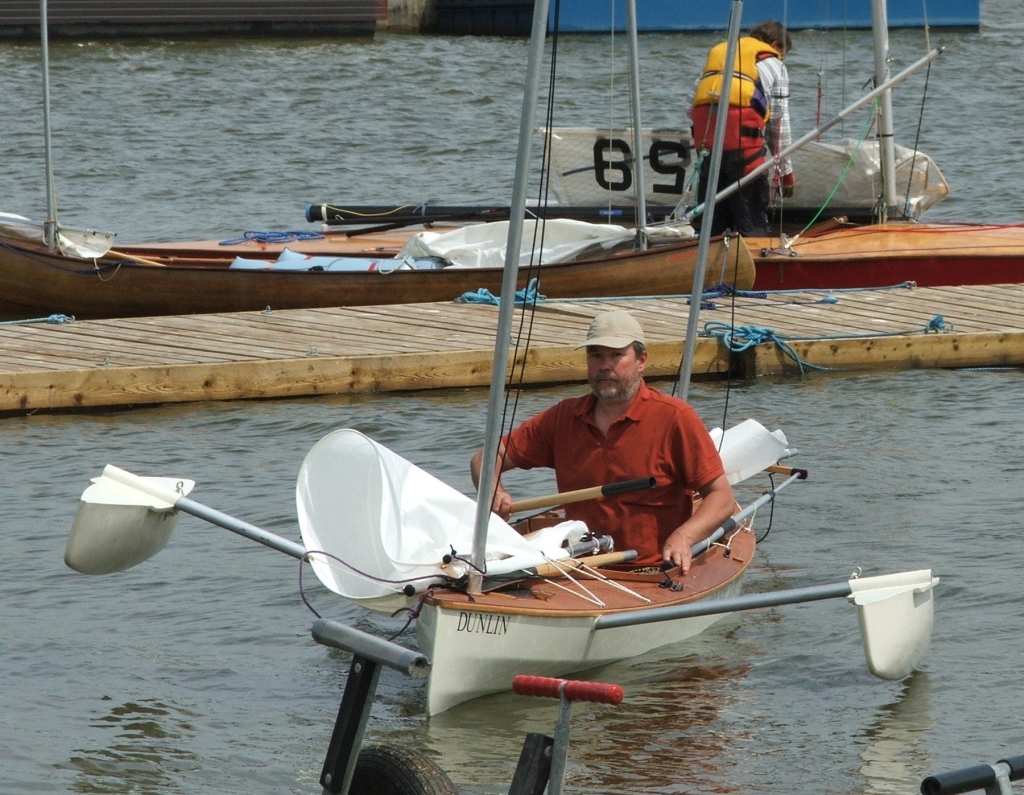
Dunlin, being sailed by Dave Stubbs, is a Solway Dory prototype plywood kayak with outriggers and ketch rig having its first outing on Hickling Broad.
It is possible to use a board tied to a point in the centre of the boat with just enough length to reach the gunwale. The board is then tossed over the lee side of the boat and water pressure alone holds it in place. The disadvantage with this approach is that it must be changed to the opposite side with every tack. Some canoes have a centre board fitted but, for most, the intrusion it creates in the hull, so reduces the capacity of the boat for crew or camping gear that its greater efficiency is not deemed worth it.

Solway Dory's trimaran test bed for an electric outboard, using a 100 amp hour battery.
If you are thinking about converting an existing canoe, then members of the OCSG will certainly offer help and Solway Dory (www.solwaydory.co.uk) can supply any parts you can't obtain locally. If you can get your boat to the Lake District, they can fit them too.
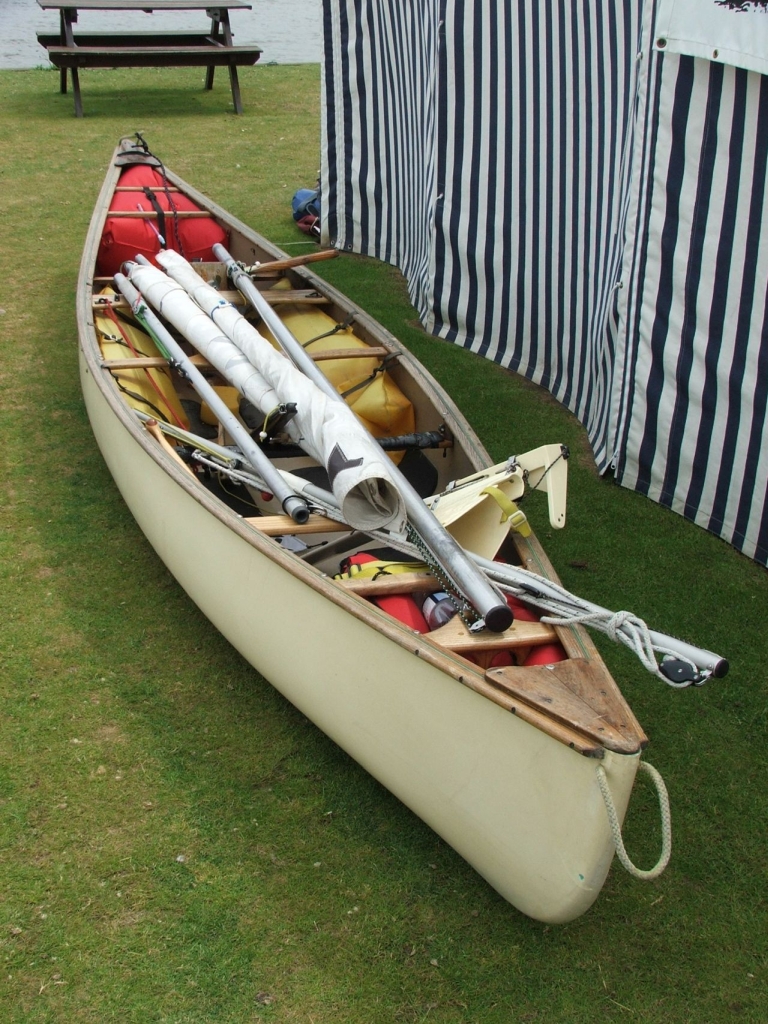
Keith Morris, OCSG Commodore's, converted Mad River Explorer ready to transport home. Note the two rigs and strap-on rudder assembly.
